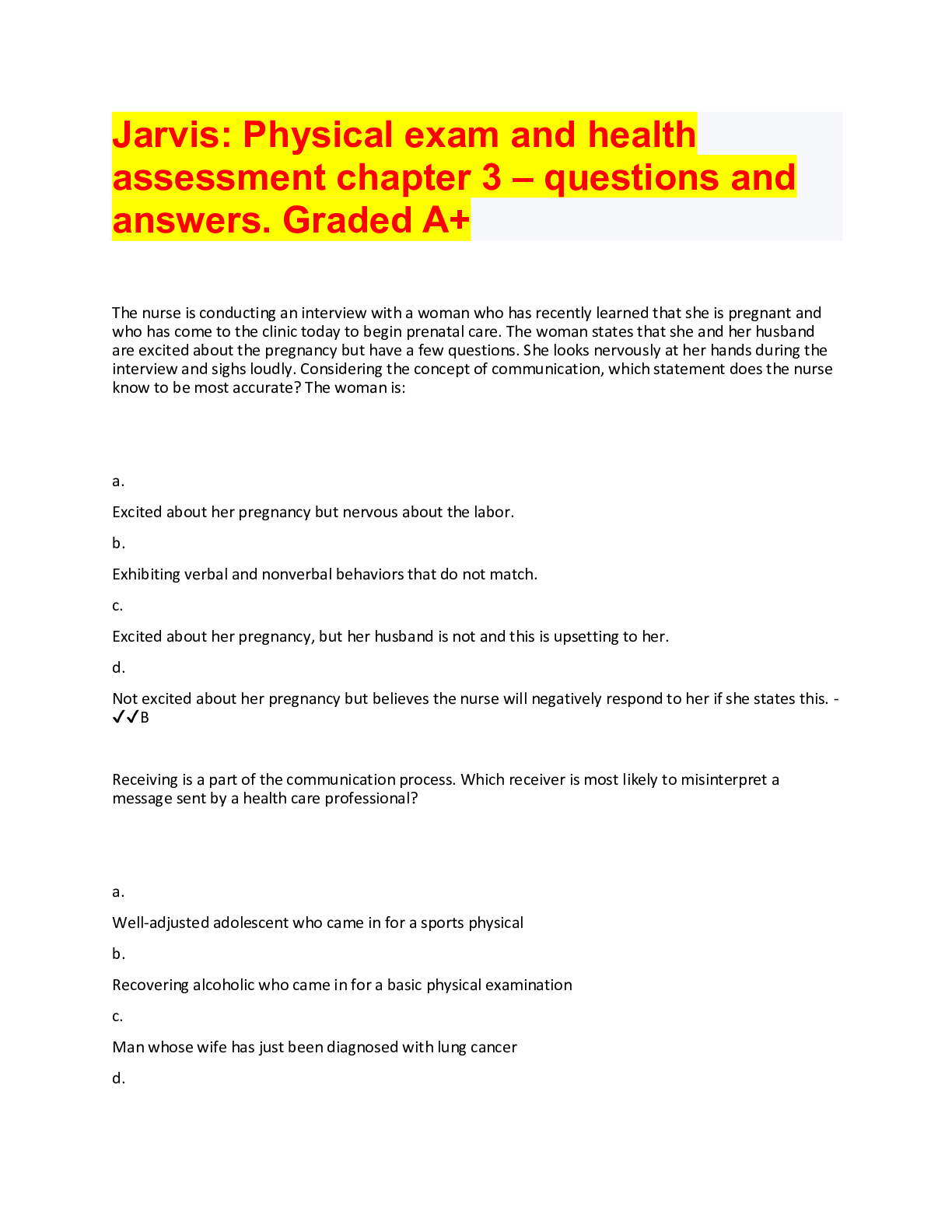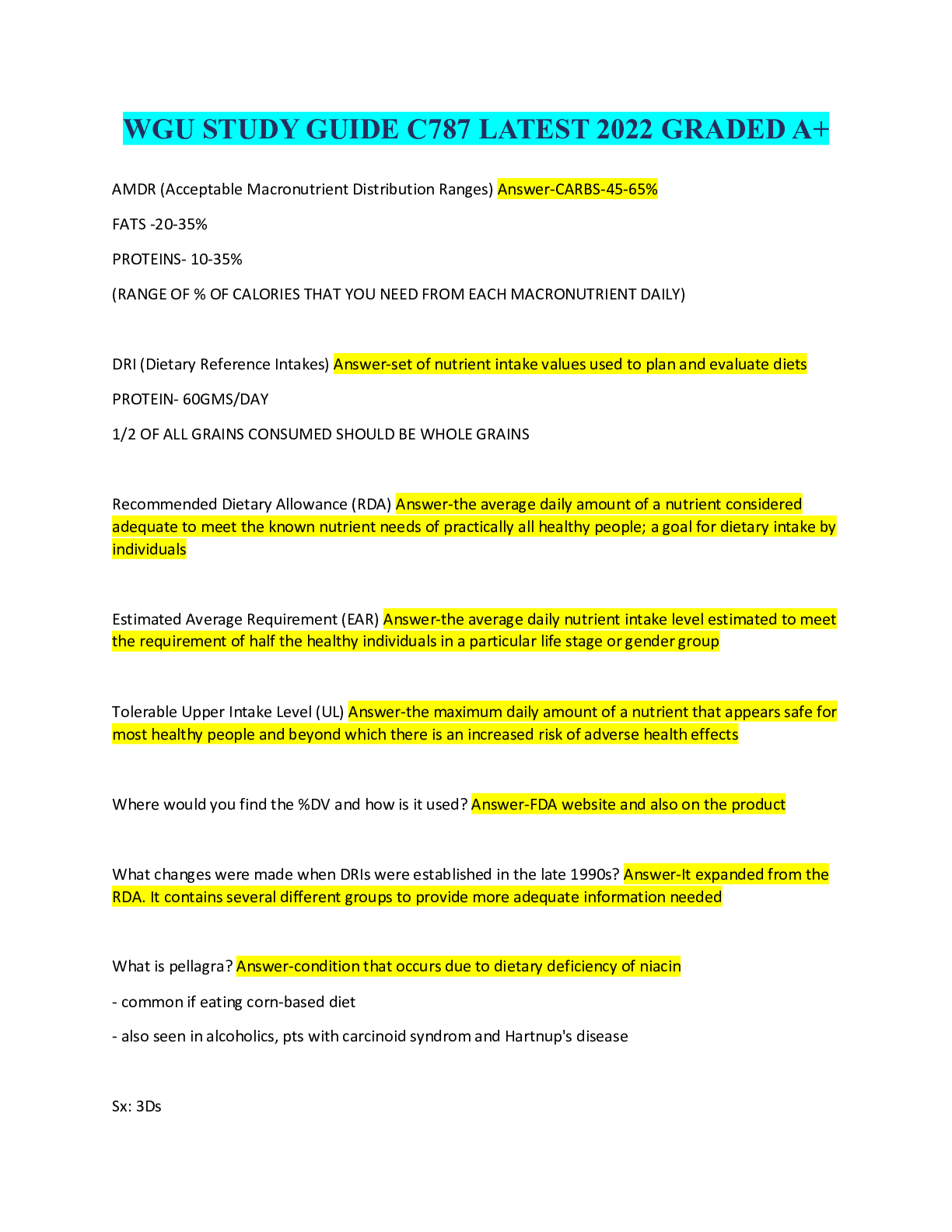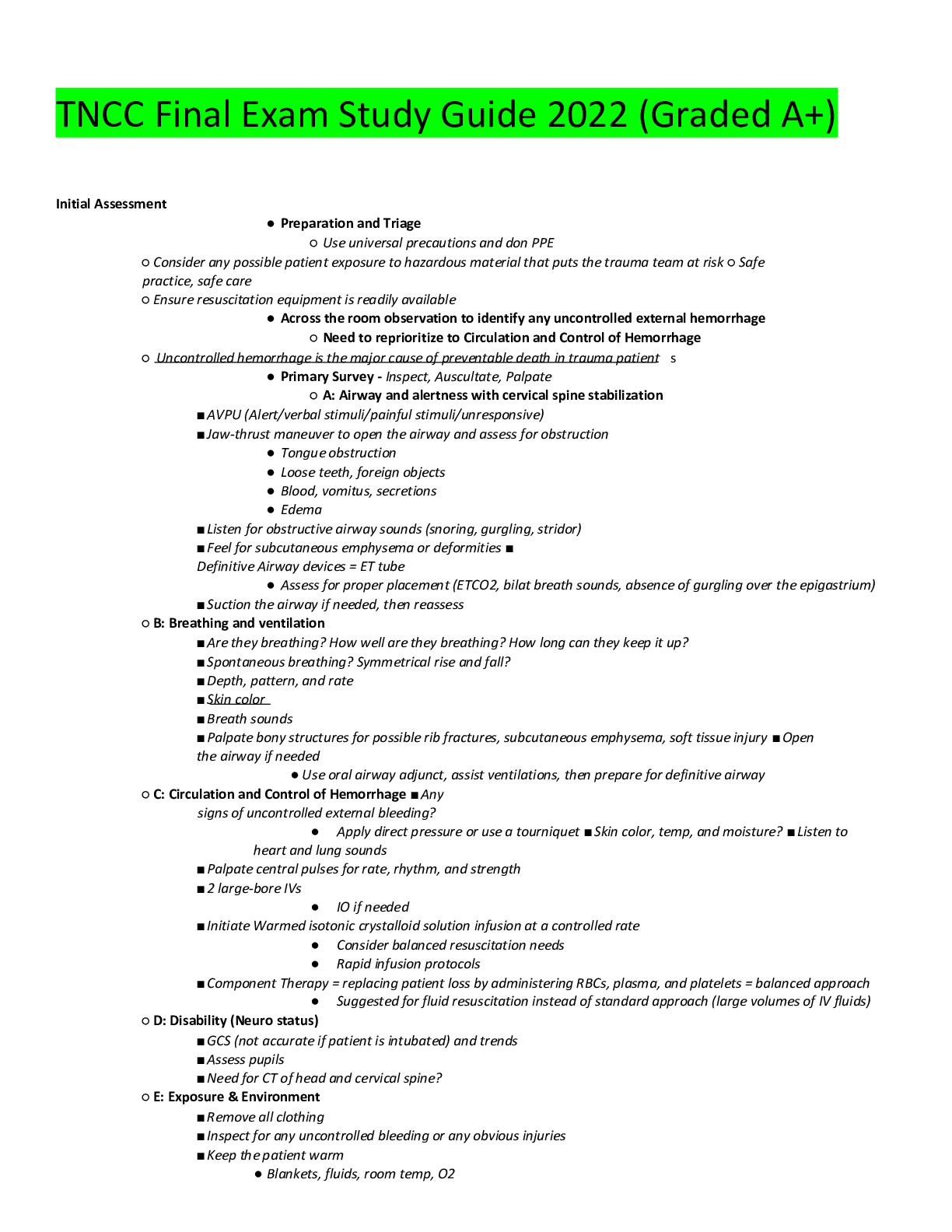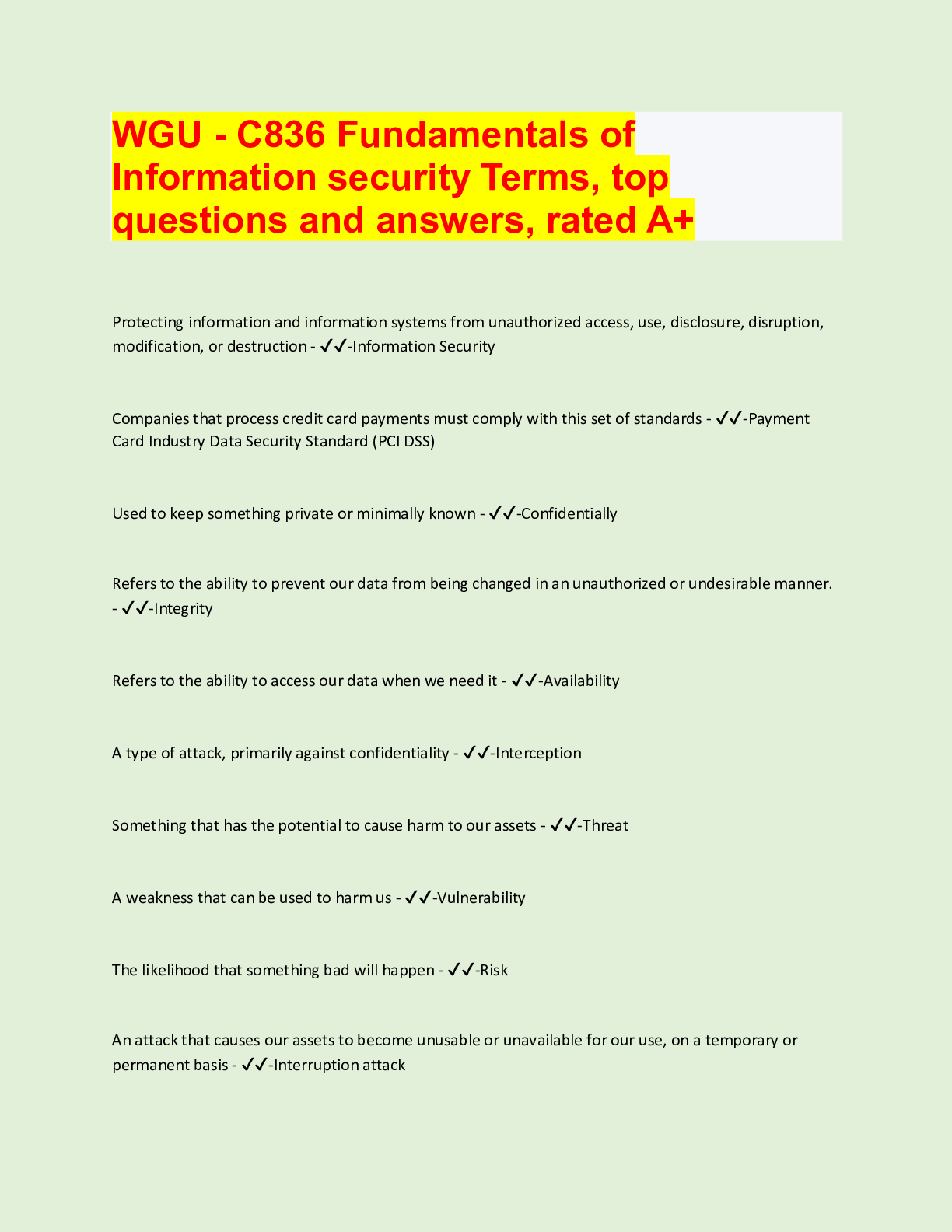*NURSING > STUDY GUIDE > Jarvis HA Ch 22 Musculoskeletal System Q&A. 2022 update, rated A+ (All)
Jarvis HA Ch 22 Musculoskeletal System Q&A. 2022 update, rated A+
Document Content and Description Below
Jarvis HA Ch 22 Musculoskeletal System Q&A. 2022 update, rated A+ ligament - ✔✔fibrous bands running directly from one bone to another that strengthen the joint tendon - ✔✔strong fib... rous cord that attaches muscle to a bone flexion - ✔✔bending of limb at a joint, decreasing joint angle extension - ✔✔straightening a limb at a joint, increasing the joint angle abduction - ✔✔moving a body part away from the axis or the median line adduction - ✔✔moving a body part toward the center or toward the median line pronation - ✔✔turning the forearm so that the palm is down circumduction - ✔✔moving the arm in a circle around the shoulder inversion - ✔✔moving the sole of the foot inward at the ankle eversion - ✔✔moving the sole of the foot outward at the ankle dorsal - ✔✔directed toward or located on the surface plantar - ✔✔surface of the sole of the foot protraction - ✔✔moving a body part forward retraction - ✔✔moving a body part backward patella - ✔✔kneecap rheumatoid arthritis - ✔✔chronic, systemic inflammatory disease of joints and surrounding connective tissue ganglion - ✔✔round cystic, nontender nodule overlying a tendon sheath or joint capsule, usually on dorsume of wrist scoliosis - ✔✔S-shaped curvature of the thoracic spine talipes equinovarus - ✔✔(clubfoot) congenital deformity of the foot in which it is plantar flexed and inverted ankylosis - ✔✔immobility, consolidation, and fixation of a joint because of disease, injury, or surgery; most often due to chronic rheumatoid arthritis ataxia - ✔✔inability to perform coordinated movements bursa - ✔✔enclosed sac filled with viscous fluid located in joint areas of potential friction crepitation - ✔✔dry crackling sound or sensation due to grating of the ends of damaged bone dupuytren's contracture - ✔✔flexion contractures of the fingers due to chronic hyperplasia of the palmar fascia hallux valgus - ✔✔lateral or outward deviation of the great toe kyphosis - ✔✔outward or convex curvature of the thoracic spine, hunchback lordosis - ✔✔inward or concave curvature of the lumbar spine nucleus pulposus - ✔✔center of the intervertebral disc olecranon process - ✔✔bony projection of the ulna at the elbow range of motion (ROM) - ✔✔extent of movement of a joint sciatica - ✔✔nerve pain along the course of the sciatic nerve that travels down from the back or thigh through the leg and into the foot supination - ✔✔turning the forearm so that the palm is up torticollis - ✔✔(wryneck) contraction of the cervical neck muscles, producing torsion of the neck List 4 signs that suggest acute inflammation in a joint - ✔✔swelling, heat, redness, and pain 3 main parts of the musculoskeletal system - ✔✔muscles, bones and joints how many bones are in the body - ✔✔206 nonsynovial joints - ✔✔bones are connected by fibrous tissue or cartilage synovial joints - ✔✔bones are separated from each other and meet in a cavity filled with synovial fluid, a lubricant during an assessment of the spine, the patient would be asked to (FEAR) - ✔✔flex, extend, abduct, and rotate pronation and supination of the hand and forearm are the result of the articulation of the the - ✔✔radius and ulna anterior and posterior stability is provided to the knee joint by the - ✔✔anterior and posterior cruciate ligaments a 79 year old woman has come for a health exam. which of the following is a common age-related change in the curvature of the spinal column - ✔✔kyphosis the timing of a joint pain may assist the examiner in determining the cause. The joint pain associated with rheumatic fever would - ✔✔occur 10 to 14 days after an untreated sore throat examination of the shoulder includes four motions. These are: - ✔✔forward flexion, internal rotation, abduction, and external rotation the bulge sign is a test for - ✔✔swelling in the suprapatellar pouch the examiner is going to measure the patient's legs for length discrepancy. the normal finding would be - ✔✔within 1 cm of each other a 2 year old child has been brought to the clinic for a health examination. a common finding would be - ✔✔lordosis state 4 landmarks to note when checking an adolescent for scoliosis - ✔✔unequal shoulder elevation, unequal scapulae, obvious curvature, and unequal hip level describe the correct method for use of the goniometer - ✔✔extend joint to neutral or 0 degrees; center 0 point on goniometer on the joint; keep fixed arm of the goniometer on the 0 line and use the movable arm to measure; flex the joint and measure through the goniometer to determine the angle of greatest flexion. differentiate testing of active range of motion versus passive range of motion - ✔✔Active ROM is done when a person can do the exercises by himself; Passive ROM exercises are done for a person by a helper. The helper does the ROM exercises because the person cannot do them by himself. dislocation - ✔✔Displacement of a body part, especially the temporary displacement of a bone from its normal position. subluxation - ✔✔Incomplete or partial dislocation of a bone in a joint. contracture - ✔✔abnormal shortening of muscle tissue, rendering the muscle highly resistant to passive stretching. The nurse suspects carpal tunnel syndrome in a patient. Which assessment technique would the nurse perform on the patient? Ask the patient to touch chin to chest. Ask the patient to open the mouth maximally. Ask the patient to raise each leg with the knee extended. Ask the patient to hold both hands back to back while flexing the wrists 90 degrees. - ✔✔Ask the patient to hold both hands back to back while flexing the wrists 90 degrees. The Phalen test reproduces numbness and burning in a person with carpal tunnel syndrome. It is a disorder of the wrist. To perform the Phalen test, the patient is asked to hold the hands back to back while flexing the wrists 90 degrees. Acute flexing of a normal wrist for 60 seconds produces no symptoms in a person not affected by carpal tunnel. Touching chin to chest and lifting the chin toward the ceiling tests the function of the cervical spine. Asking the patient to open the mouth maximally assesses the proper functioning of the temporomandibular joint. Raising each leg with the knee extended assesses the functioning of the hip joint. Which characteristic feature indicates a positive Allis sign? Difference in the level of scapulae Burning sensation along the median nerve Presence of one knee lower than the other Presence of numbness while flexing the wrist - ✔✔Presence of one knee lower than the other The Allis test helps in assessing for hip dislocation. The nurse performs this test by comparing the lengths of the legs; the presence of one knee lower than the other indicates a positive Allis sign. A difference in the levels of the scapulae occurs in the patient with carpal tunnel syndrome. A burning and tingling sensation along the distribution of the median nerve indicates a positive Tinel sign. A positive Tinel sign is indicative of carpal tunnel syndrome. Numbness during the flexion of the wrist indicates a positive Phalen test. The nurse is caring for a patient who has rheumatoid arthritis. While performing a musculoskeletal assessment, the nurse hears a crunching or grating sound that accompanies movement of the joints. Which term will the nurse use to describe this finding? Ankylosis Crepitation Dislocation Subluxation - ✔✔Crepitation Crepitation is an audible and palpable crunching or grating sound associated with movement. In diseases such as rheumatoid arthritis, the articular surfaces in the joints become rough and the synovium becomes inflamed, causing crunching or crepitation. Ankylosis is stiffness or fixation of a joint; it does not produce a crunching sound with movement. Dislocation is a complete loss of contact between the two bones of a joint. Dislocation is also not associated with the grating of joints. In the case of subluxation, two bones in a joint stay in contact, but their alignment is disrupted. Which disease conditions are associated with hard, nontender Heberden and Bouchard nodules? Scoliosis Osteoporosis Osteoarthritis Carpal tunnel syndrome - ✔✔Osteoarthritis The bony outgrowths of distal interphalangeal joints are called Heberden nodes, and the bony outgrowths of proximal interphalangeal joints are called Bouchard nodes. Osteoarthritis is characterized by hard, nontender Heberden and Bouchard nodules. Scoliosis is characterized by the lateral curvature of the thoracic and lumbar segments of the spine. Osteoporosis is a bone disorder characterized by a decrease in bone mass and density, which increases the risk of fractures. Carpal tunnel syndrome results in pain, burning, and numbness. It occurs due to atrophy of the median nerve of the wrist and hand. The nurse is caring for a patient who has been experiencing axial skeletal pain for 3 months and who reports mental confusion and forgetfulness. The nurse finds that the patient also has insomnia and fatigue. Which condition does the nurse anticipate in the patient? Scoliosis Achilles tenosynovitis Fibromyalgia syndrome Herniated nucleus pulposus - ✔✔Fibromyalgia syndrome Fibromyalgia syndrome manifests as a widespread pain in the muscles. The patient with fibromyalgia syndrome may also have fatigue and insomnia along with the pain. This condition may cause psychosocial distress in the patient, leading to cognitive problems such as mental confusion and forgetfulness. Lateral curvature of the thoracic and lumbar segments of the spine indicates scoliosis in the patient; this patient will not necessarily have cognitive problems. Inflammation of a tendon sheath near the ankle is a sign of Achilles tenosynovitis. This condition will not manifest as a widespread pain in the axial skeleton. Nucleus pulposus present in the center of the intervertebral disc ruptures into the spinal canal, causing pressure on the spinal nerves. This condition is known as herniated nucleus pulposus. The patient with herniated nucleus pulposus will have severe pain, but not cognitive problems. The nurse is assessing the integrity of the spinal accessory nerve (cranial nerve XI). What should the nurse ask the patient to do? Shrug the shoulders Touch chin toward each shoulder Stick out the lower jaw Lift the chin toward the ceiling - ✔✔Shrug the shoulders The integrity of the spinal accessory nerve (cranial nerve XI) is checked by asking the patient to shrug the shoulders. Touching the chin towardd each shoulder and lifting the chin toward the ceiling test the function of the cervical spine. Sticking out the lower jaw checks the proper functioning of the temporomandibular joint. Which test helps in screening a child's fine and gross motor skills? Allis test Ortolani test Tinel sign test Denver II test - ✔✔Denver II test The Denver II test helps the nurse in screening a child's fine and gross motor skills. The nurse assesses the overall development of the child. The Allis test helps assess for hip dislocation. The Tinel sign test helps diagnose carpal tunnel syndrome. The Ortolani test helps assess developmental dysplasia of the hip. While performing the McMurray test on a patient who has swelling at the knee joint, the nurse feels a click. Which complication does the nurse suspect in the patient? Scoliosis Hallux valgus Torn meniscus Carpal tunnel syndrome - ✔✔Torn meniscus A torn meniscus is damage to the cartilage present at the knee joint. This may cause swelling and pain at the site. The nurse holds the heel of the patient and asks the patient to flex the knee and hip. A positive McMurray test or a click sound while performing the McMurray test indicates a torn meniscus. Lateral curvature of the thoracic and lumbar segments of the body indicates scoliosis. This is a spinal abnormality, and the patient with scoliosis will not have pain in the knee joint. Outward deviation of the toe with medial prominence of the head of the first metatarsal indicates hallux valgus. Numbness and a burning sensation in the joint is a characteristic sign of carpal tunnel syndrome. The patient with carpal tunnel syndrome will not show a positive McMurray sign. During the assessment of a patient, the nurse finds that the distal part of the great toe is directed away from the body's midline. Which complication is present in the patient? Polydactyly Crepitation Hallux valgus Carpal tunnel syndrome - ✔✔Hallux valgus Generally, the toes point straight forward and lie flat. Hallux valgus is a deformity in which the great toe deviates away from the medial prominence of the head of the first metatarsal. The patient with polydactyly has extra fingers or toes. Crepitation refers to the audible and palpable crunching sound that occurs while moving the joints. The patient with carpal tunnel syndrome may have a burning and tingling sensation in the joint. While performing a head-to-toe assessment on a patient, the nurse instructs the patient to rest in a supine position. The nurse tells the patient, "Raise each leg and extend your knees." What is the nurse focusing on in this part of the assessment? The hips The knees The shoulders The cervical spine - ✔✔The hips This portion of the assessment is focusing mainly on the hips. To check the flexion of hips, the patient first needs to rest in a supine position and then raise each leg and extend the knees. To test the functional mobility of the shoulders, the patient first moves both the arms forward and up in a wide vertical arc, and then moves the arms back at the sides with the elbows extended. Touching chin to chest and lifting the chin toward the ceiling tests the functionality of the cervical spine. The expected result of this test is to observe hip flexion of 90 degrees. This position cannot detect the viability of the knee joints, because the knees need to dangle to be assessed correctly. The nursing instructor is teaching a class on the types of joints. Which statement by the student nurse about synovial joints indicates effective learning? "Synovial joints are immovable and united by cartilage." "Synovial joints are freely movable and lined with synovial membranes." "Synovial joints are slightly movable, and the bones [Show More]
Last updated: 2 years ago
Preview 1 out of 23 pages

Buy this document to get the full access instantly
Instant Download Access after purchase
Buy NowInstant download
We Accept:

Also available in bundle (1)

Jaarvis Bundle, Latest updates 2022.
This bindle comprises of all the Jarvis exam questions and answers documents, Graded A+.
By bundleHub Solution guider 2 years ago
$40
20
Reviews( 0 )
$8.00
Can't find what you want? Try our AI powered Search
Document information
Connected school, study & course
About the document
Uploaded On
Aug 23, 2022
Number of pages
23
Written in
Seller

Reviews Received
Additional information
This document has been written for:
Uploaded
Aug 23, 2022
Downloads
0
Views
79














